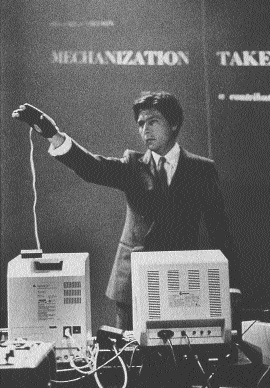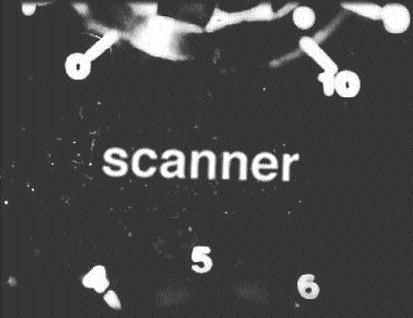Lo-fi nostalgia and the music of aural voyeurism
John Potts considers the work of sound artists Scanner and Paul DeMarinis

Paul DeMarinis
Two sound artists with a keen interest in technology visited Australia late last year. Scanner (Robin Rimbaud) from the UK, toured Australia in October (as part of ANAT’s Virogenesis), while Paul DeMarinis, from the US, visited Sydney in November. Their perspectives on audio technology differ widely. De Marinis’ works reveal a fascination with the history of recorded sound; Scanner’s performances are interceptions of contemporary communications. Taken together, the two artists offer intriguing angles on our techno-mediated soundscape.
DeMarinis entertained his Artspace audience with a whimsical account of his career. “What’s wrong with thinking and laughing at the same time?” he asked rhetorically, before outlining his trajectory through the worlds of sound and technology. A similar ambivalence pervades many of his works, which simultaneously deconstruct and celebrate the properties of sound reproduction devices.
From a background in classical music, DeMarinis moved in the 1970s into the field of electronics, which he incorporated into sculptures and installations. One early performance, “A Byte At The Opera” (1975), used home-made synthesisers. DeMarinis customised the new products of the electronics industry, including speech synthesisers. This “relationship” flowed the other way as well: in 1980 DeMarinis invented touch-play computerised instruments, intended as jamming instruments for multiple musicians. This device was later adopted by the electronics industry as a child’s instrument, much to DeMarinis’ amusement. As digital audio sampling and triggering devices became more sophisticated, DeMarinis deployed his own versions of these techniques in performance. “Alien Voices” (1989) was an interactive work for voices treated in real time, while his Power Glove triggering performance was a major event at TISEA, held in Sydney in 1992.
His most remarkable works, however, were exhibited during the early 1990s as representatives of “The Edison Effect”: works which presented their own technology as contraption, a bricolage of historical developments. For example, one device played old vinyl records with lasers, resulting in a mix-tech lo-fi. In another work, a laser projected through a goldfish bowl plays a phonograph, except when the goldfish swims across the path of the laser. Other more recent works include clay recording (sound “inscribed” in clay), lasers emerging from syringes, film soundtracks encoded on spiral hypno-discs, beeswax recordings which reportedly also record smells, and a speech by Stalin re-recorded onto a lacquer disc. The appeal of these works is readily apparent wherever they are exhibited: makeshift apparatus made of techno-flotsam, they are both amusing and intriguing. But why is DeMarinis so obsessed with the mismatching of sound technologies?
One clue to his motivation emerged as he discussed his recent works. For all their playful juxtaposition, these lo-fi devices still reproduce sound, however unfaithfully. In playing the recordings, they are also playing themselves, a fact which DeMarinis finds fascinating. “With sound,” he said, “you need a machine to play back the recording, unlike photography, where you only need the photo. Phonography means you have the machine playing back the artefact made by the machine. I like hearing the noise of the machine that’s making the illusion: that’s real physical listening. Each reproduction technique makes its own signals; at the time you may pretend the signal isn’t there, as in vinyl records, and call it hi-fi; now, people are nostalgic for that noise.”
DeMarinis’ works refer, sometimes obliquely, to other aspects of our mechanically/electronically reproduced sound world. The repetition of machine culture is, he says, addictive, with the machine in the role of compulsive behaviour. As if by way of antidote, his works are sometimes disruptive (such as the goldfish laser) or faulty. “You get a sound cloud, a non-distinct impression in these recordings played by laser. It’s more like a flavour or a cloudiness.” As well, by meddling with the history of technology, his devices display another attribute of technology: that it creates its own set of artefacts. “We live in the only age where we’re surrounded by our own archaeology.”
If DeMarinis is a meddler in audio archaeology, Scanner is a sifter through the aural debris of the contemporary world. His performances are built around a handheld radio receiver which scans the vicinity for cellular phone conversations. The unsuspecting conversationalists are sampled and worked into musical performances generated by a module and sequencer. Each performance thus has a live, unpredictable content and “local colour” courtesy of the scanned conversation; more importantly, each performance involves an aural voyeurism on behalf of the audience.
Listening to such a performance invokes a complex range of responses. There is fascination as you eavesdrop on a private conversation which may head in any direction. There is the thrill of participating in this illicit and, presumably, illegal act. There is uneasiness regarding the invasion of privacy you are involved in. There may even be guilt. At times there is a sense of melancholy, especially if the conversation is mixed with an ambient synthesiser motif. There is also an appreciation of the technological character of the mediated voice, as it becomes one element of an electronic composition. Consequently, the listener may be moved, troubled, disturbed or exhilarated by a Scanner performance – or perhaps a mixture of all of these.
 Scanner is acutely aware of all these factors, as became apparent when he answered listeners’ questions after a Sydney performance. The scanning device picks up an enormous range of transmissions, he said, including microwave ovens, hearing aids, even astronauts; phone conversations occupy only a narrow range of frequencies. The texture of the radio transmission lends itself to aesthetic treatment, as does the emotional impact of some of the scanned conversations. The scanning technology is part of a battery of surveillance devices which alarms many guardians of individual privacy. How does Scanner deal with these concerns? Is he complicit in the erosion of privacy by technologically enhanced systems: government, media, other?
Scanner is acutely aware of all these factors, as became apparent when he answered listeners’ questions after a Sydney performance. The scanning device picks up an enormous range of transmissions, he said, including microwave ovens, hearing aids, even astronauts; phone conversations occupy only a narrow range of frequencies. The texture of the radio transmission lends itself to aesthetic treatment, as does the emotional impact of some of the scanned conversations. The scanning technology is part of a battery of surveillance devices which alarms many guardians of individual privacy. How does Scanner deal with these concerns? Is he complicit in the erosion of privacy by technologically enhanced systems: government, media, other?
Scanner doesn’t shirk this issue; in fact he revels in it. His performances are vivid demonstrations of how easily an individual’s rights may be violated. They are, he claims, “an illustration of the illusion of privacy”. By partaking of this process, he is also commenting on it, in a mediated world where public and private are increasingly blurred. People wilfully conduct private conversations in public spaces, via mobile phones. Reality TV, which converts private lives into public property, is, he asserts, “distressing”; the British press has become notorious through its exposure of celebrities’ private moments, faked or otherwise. Closed-circuit TV systems, ostensibly introduced to combat crime, in reality further the power of surveillance.
Scanner’s performances and recordings foreground the ubiquity of such technology, as do, in a different manner, the works of Paul DeMarinis. While DeMarinis’ pieces have a whimsical air as part of their nature, Scanner’s art contains a darker, more menacing mood. Perhaps it is the presence of the human voice, inserted into the technological apparatus implied by Scanner’s works, that generates a certain melancholy. It is the vulnerability of the voice in the face of the technology that would record, reproduce, or intercept it.
RealTime issue #17 Feb-March 1997 pg. 12






